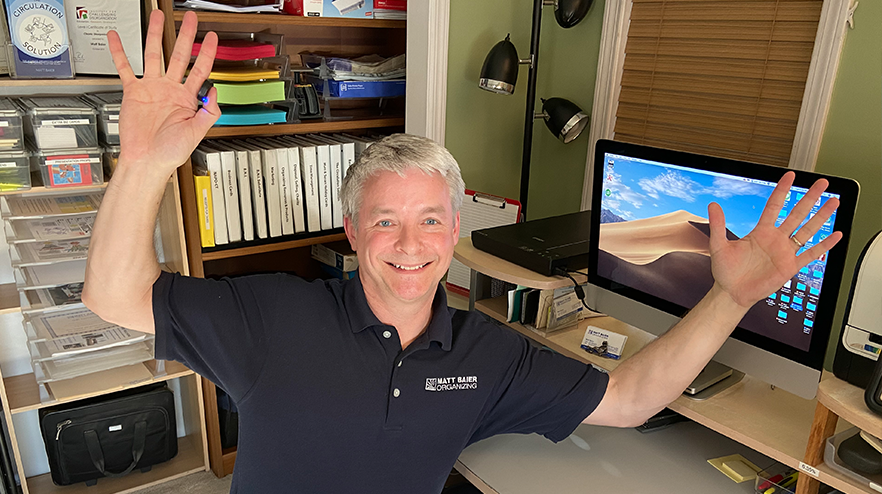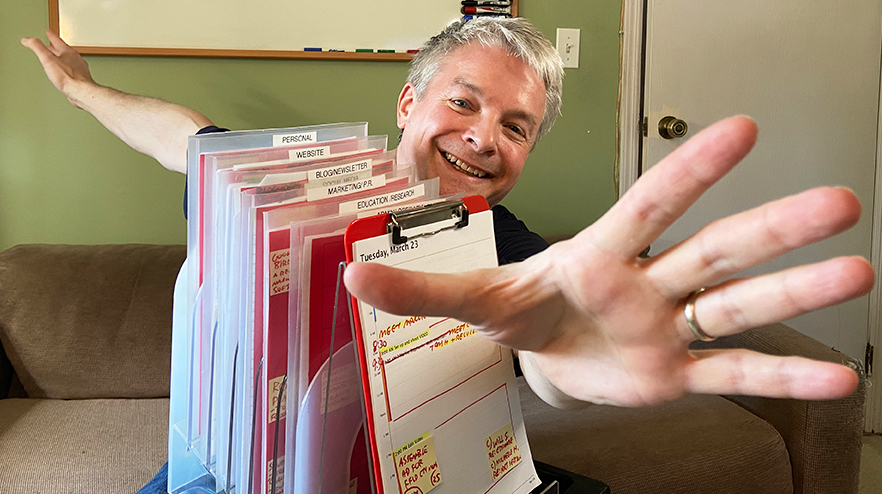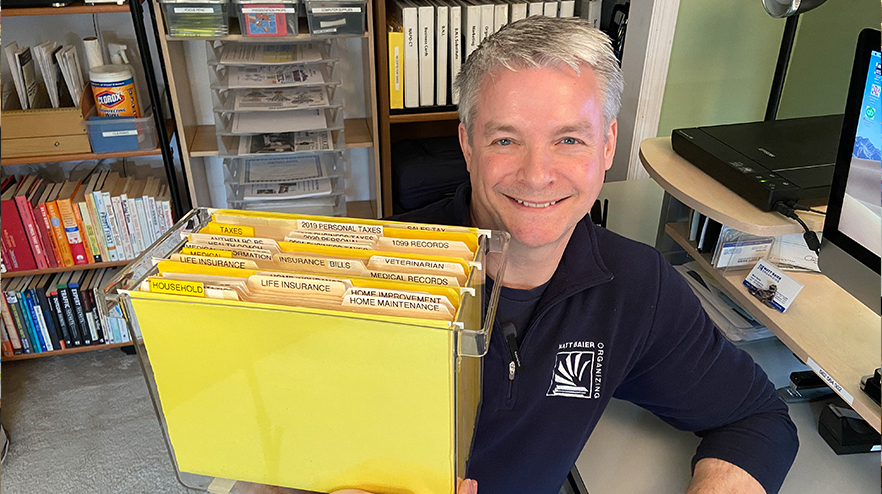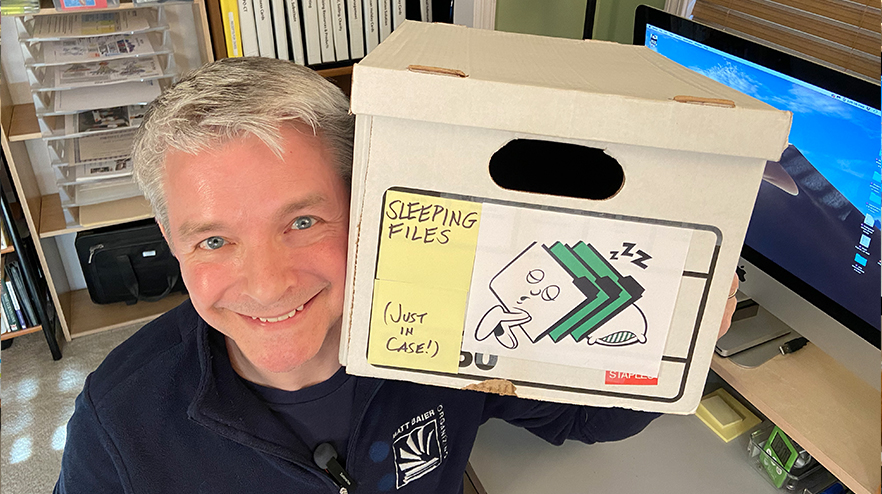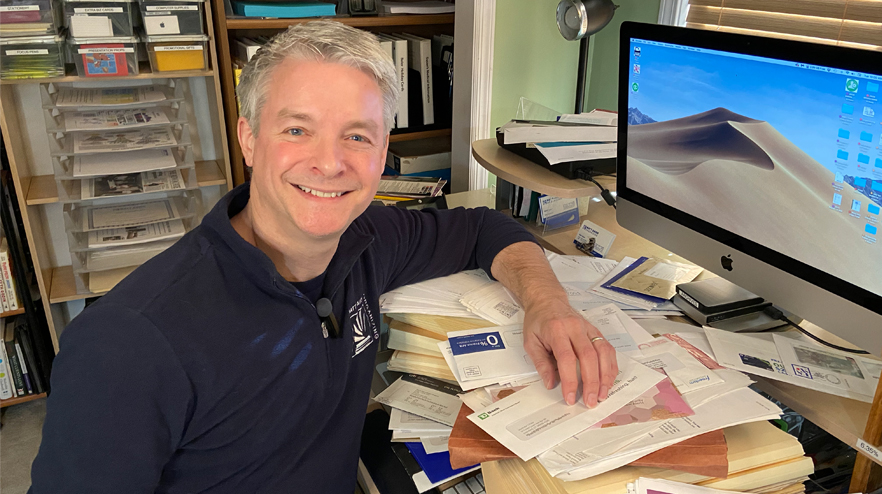Originally from Matt Baier’s Organizing Works Newsletter, April 2007
FOCUS ON FILING, PART 1: THE FILE CYCLE
“80% of papers that are filed are never referenced again.” Small Business Association
Do you sometimes feel like you don’t know where to begin when your desk is covered in papers? If it was simply a matter of tossing it all in the trash you would have done that already. They ARE all important, but as soon as you start addressing one of them, another more pressing one grabs your attention, then you need a supporting document, but you can’t find it in your file cabinet. It must be in one of your “to file” piles, but that might have been buried under last week’s mail. Sound familiar? If it does, you’re not alone.
There are many reasons why filing can be challenging: Your file cabinet may not be accessible enough; your system may be too complicated or confusing; you may not trust your file cabinet; or you may believe you will never get to anything unless it is out where you can see it. I will address all these concerns in this three part focus on filing, but I am going to begin with a new way of looking at files that I call the File Cycle.
The relevance of most files is not locked in time. From ream to recycle, a file can essentially be broken down into FOUR stages:
1. Running Files
2. Sitting Files
3. Sleeping Files
4. Dead Files
I am a big believer in filing by category, but before we get to that, these are the four stages to be aware of. Understanding what belongs in each of these stages may free up a full 75% of your file cabinet and clear those piles on your desk for good. Here’s how it works.
Running Files. Got ongoing projects that you’re not ready to put away yet? Then don’t. I currently have 9 ongoing projects and 27 client files OUT, yet 75% of my desk space is clear when I start work in the morning. How is this possible? I keep well labeled files in incline sorters, freeing up the majority of my valuable desk space for processing work. You don’t have to be a naturally organized person to put things in a place that makes sense, you just need a place that makes sense. When these projects and clients become less relevant they evolve into the next stage of a file’s life: Sitting Files.
Sitting Files. Sitting files are what belong in an easily accessible filing cabinet. These include former Running Files, current (2007) files, and older (but currently relevant) records you may need to access. Sitting files should be close to your desk, if not built into it, for easy access. In homes, I recommend a two drawer file cabinet and no more (see featured product). Convinced you need your two 4 drawer file cabinets? Read on.
Sleeping Files. Perhaps the most important filing stages to distinguish between are the Sitting stage, when you have to be able to lay your hand upon a file instantly, and the Sleeping stage, when you are hanging on to a file just in case. I have helped reduce clients filing space by 75% simply by addressing their Sleeping Files. Get these into banker boxes or plastic boxes, if you are concerned about moisture, and store them more remotely in a basement, attic, or storage locker. Be sure you label and date them clearly, so that in the unlikely event that you should need to wake one of them up you can. Don’t organize much beyond that. Save your organizing time for the more relevant Sitting Files.
Dead Files. This stage may seem obvious, but it is important to remember that after a few years, the Sleeping Files lose their value completely. You may pull a file out of your file cabinet and ask yourself “Am I ever going to need this again.” If you have serious misgivings about tossing it, then don’t. Store it with the Sleeping Files for a few years and see if you ever miss it. With this holding time, you make the decision to toss substantially easier. Otherwise, toss as much as you can. Just as dead leaves can drain the life from a plant, so too can dead files deprive your more important documents of circulation. So give your files a regular pruning!
A great time to circulate your files is the first Saturday after April 15th. Perhaps the most important reason to keep files at all is as supporting documentation for your taxes. Once your taxes are paid, you can take all the 2006 files out of your file cabinet and store them more remotely in a bankers box. By converting Sitting files into Sleeping Files you free up your file cabinet to easily accommodate incoming 2007 files. It’s also a great opportunity to look at all those old Sleeping files. Check with your Accountant first, but odds are good that you can circulate those boxes of supporting tax materials from the 1990s right into the circular file.
Featured Product- HON 2 drawer file cabinet.
Perhaps recommending a filing cabinet in a filing newsletter seems incredibly obvious, but I’m amazed at how many households don’t have a file cabinet or settle for a low quality one. It is well worth paying a little extra for a good quality file cabinet because it can last a lifetime and it encourages more use. That’s right. If a file cabinet is solidly constructed and has a smooth gliding action, you will be more likely to open and close it. As silly as that may sound, it is an important first step in user friendly filing. If you get in the habit of circulating your files, as recommended in this newsletter, two drawers is more than enough in most households. Also, two drawers gives you an added benefit: extra surface space, a highly underrated tool in every office.
Not all files are created equal. It is alright to keep important ongoing projects out where you can see them, but have a system that keeps your desk clear; keep a file cabinet of readily accessible files close to your desk; store files that you need just-in-case more remotely; and toss as many unimportant files as you can. The goal is to clear away what is unimportant so that you can easily see and access what IS important. The vehicle that will get you there is the File Cycle.
Please Share With Your Community











